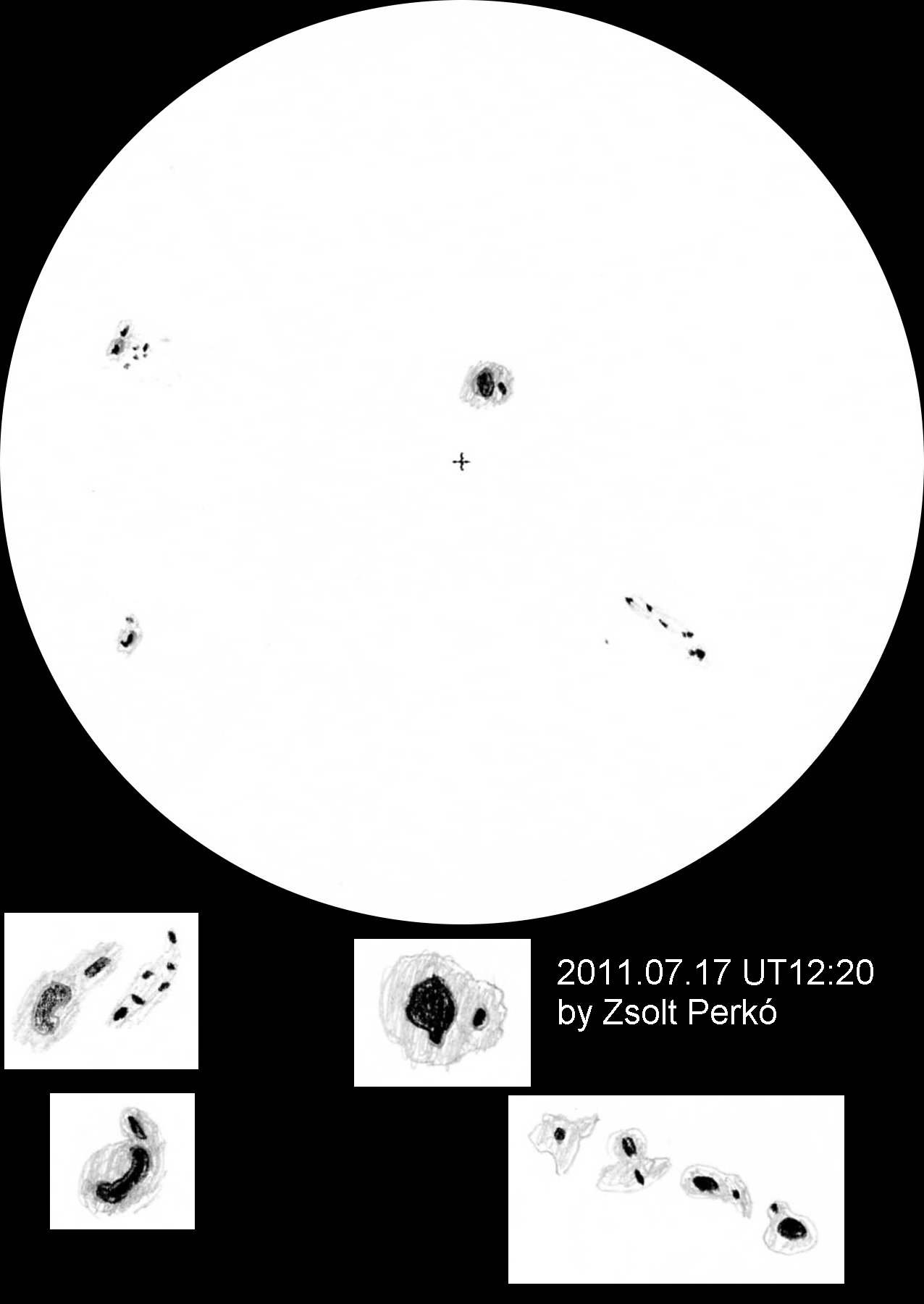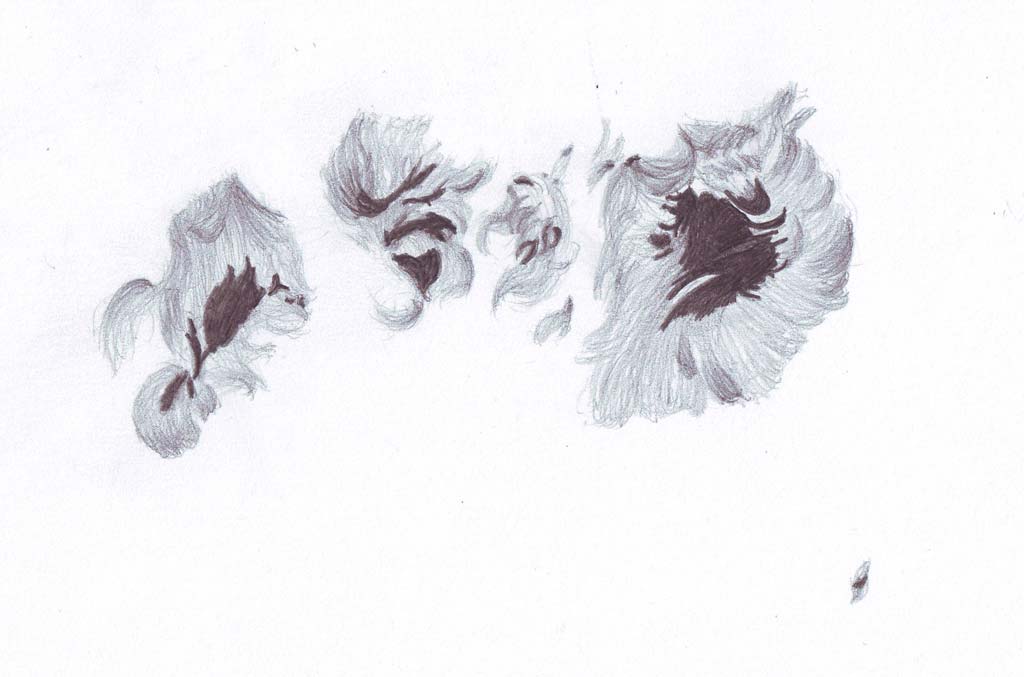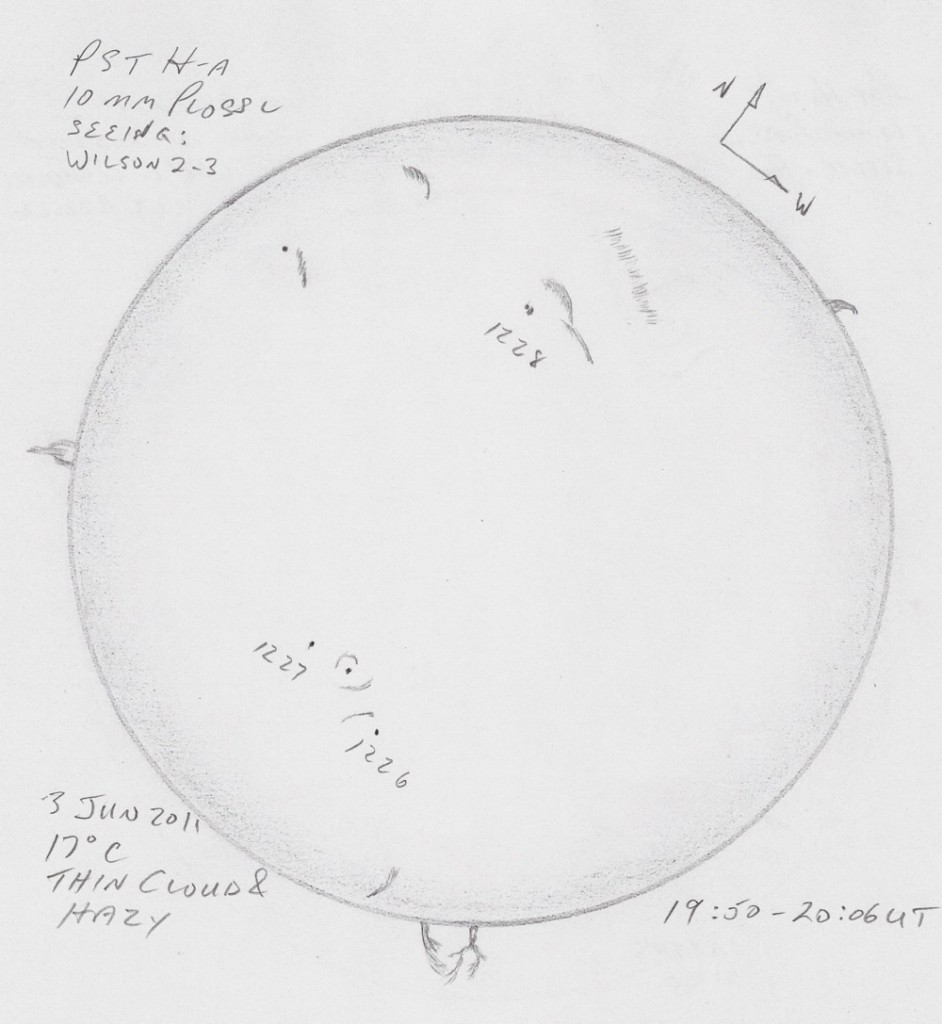
Location: Hungary – Nagykanizsa, Canis Maior Solar Observatory
Date: 2011-July-17
Media: graphite pencil, white paper
SkyWatcher 120/1000, 38x, Baader solar filter foil
My very first sun sketch

Object name: Sunspots / Sun
Object Type: Sun
Location: Budapest, Hungary, Polaris observatory
Date: 24th September 2011. UT: 12:30-13:20
Media: Graphite pencil used on white paper
Equipment used: 200/2470 refractor, Fornax 51 (7 mm Planetary) – 352x
Dear Asod,
I would like to share my sketch about the sunspots in the group 11302. I have made this sketch with a 200/2470 refractor in Polaris Observatory Budapest. This is my first sketch with this fine details at such enlargement of the object.
Unfortunately the seeing was not the best, but still I always had 1-2 seconds when everything was clear so I could sketch what I see. It was exciting to see what fine details are visible within the umbra and not only in the penumbra.
—
dr. Hannák Judit

This morning everything seemed to be right. The weather was absolutely great, the Sun was more active than I’ve seen so far this year and the seeing was above average. A good day to try sketching a full-disk h-alpha sun for the first time instead of an isolated prominence. First I made a blank disk with a soft white pastel. I took the sketch outside and filled in all the details I could see through the eyepiece of my 70mm solar telescope with white and black pastel pencils. All regions were very active, especially the middle one: it changed its shape within minutes. Sometimes little bright flare-like brightenings appeared and disappeared 2 minutes later. A wonderful sight! It took me one hour (from 08.00 UT – 09.00 UT) to complete the drawing. I scanned the (black&white) sketch and gave it a reddish color with Photoshop.
Object Name Sun
Object Type Star
Location Deventer, The Netherlands
Date August 2, 2011
Media Pastel on black paper
Kind regards,
Roel Weijenberg
www.roelblog.nl

Object Type : Sunspots
Location : Montreal, Canada
Date: September 1rst 2011
Media: HB pencils and blending stump on white acid-free sketch paper. The sketch was scanned and treated with GIMP software.
The observation was made using a 130mm Newtonian reflector and a 25X and 10X eyepiece. The sun was peppered with sunspots that day.
Jean Barbeau

Hi,
Sun sketch made on 3 June 2011 at 19:50 – 20:06 UT in Ontario Canada with a Coronado PST Ha single stack. An interesting prom appears in the SSW
The disk image is pre-printed at 16 cm diameter on computer paper and details added with mechanical pencil, scanned into my computer and contrast-adjusted with standard scanner software.
Regards,
Mel R.
2011 05 09, 1429UT-1550UT
Solar NOAA 11203, 11204, ??, 11209, 11208
www.pcwobservatory.com
PCW Memorial Observatory, Zanesville, Ohio USA – Erika Rix
DS 60mm Maxscope, LXD75, 21-7mm Zhumell, ETX70 AT w/tilt plate and white light glass filter.
All sketches done scopeside and flipped in Photoshop to match standard orientation. H-alpha sketch created with black Strathmore Artagain paper, white Conte’ crayon and pencil, Derwent charcoal pencil, black oil pencil. White light sketch created on photocopy paper with 0.5mm mechanical pencil and #2 pencil.
Transparency made it nearly impossible to view prominences at the start of the session with the thin layer of cirrus creating a milky white sky. There were small breaks that allowed me to sketch in some of the detail on a western prominence, that later as the transparency improved, showed an abundance of thin whispy structure that wasn’t captured on paper. By that time, I was already working on a full disk sketch in h-alpha. Seeing was terrific until I started on the white light observation, but had I set up the ETX at the beginning of the session to let the scope adjust to the warmth, it would have been much better by the time I observed with it. As it was, I observed in the observatory for protection of the wind as I view with a shade attached to the objective and wanted to avoid vibration.
There is a possible new active region between 1209 and 1208 that, while observing in white light, had several little spots forming an elliptical shape with pointed ends like a football. I noticed facula around 1208, but the seeing was so bad that I couldn’t make out a definite shape. The umbra of the preceding spot in that region was displaced, as was the preceding spot in 1203. I didn’t notice any sunspots in 1209 during my observation, but that may have been the result of the seeing.
The band of active regions is still putting on a nice show in h-alpha with more-defined plage around them.
– Object Name: Sun
– Object Type: Star
– Location: Lith, the Netherlands
– Date: 5-5-2011
– Media: white pastel, black paper, PhotoShop CS5
– Telescope: Coronado P.S.T.
Today was a nice clear day in Holland. The sun was shining bright, so i aimed my brand new solar telescope (Coronado P.S.T.) at it to see some Solar Flares. There where many flares visible, and also some sunspots and other details on the surface.
This is my first solar sketch in H-Alpha. The original sketch is black & white, and i changed that colour in PhotoShop.
Clear Skies!
Rutger Teule
www.rutgerteule.com
2011 05 05, 1230 UT – 1515 UT
Solar h-alpha, NOAAs 11203, 11204, 11205, 11207 and prominences
PCW Memorial Observatory, Zanesville, Ohio USA – Erika Rix, www.pcwobservatory.com
Temp: 22.5°C, Humidity 38%
Seeing: Wilson 4, Transparency: 3/6
DS 60mm Maxscope, LXD75, 21-7mm Zhumell, ETX70 AT w/tilt plate and white light glass filter.
H-alpha sketch created scopeside with black Strathmore Artagain paper, white Conte’ crayon and pencil, Derwent charcoal pencil, black oil pencil. White light sketch created on photocopy paper with 0.5mm mechanical pencil and #2 pencil.
The Sun was a little too low in the observatory for me to stay inside at the beginning of the session, so I pulled all my gear onto the grass. It was probably the best move anyway, since it warmed up quite a bit during the session.
I started off with the Maxscope for an overall view. The prominence at the western limb caught my eye initially, but it was the prominence on the eastern limb that really put on a show. It was nearly three times taller than the other and had the faintest wisps of filament reaching out connecting the brightest three areas of that prominence section.
The h-alpha full disk was filled with filaments and plage within the band of active regions. I’ve flipped the views of both the white light and h-alpha full disk sketches to match the standard view (at least a little more so as I didn’t rotate it completely) for comparisons with SOHO views. In white light, there were three distinct areas of faculae, one each on the western and eastern limbs and one around AR 11207. I couldn’t detect 1205 in white light and although the Sun had rotated slightly, I’m fairly sure 1207 is indeed that designation in my sketch and not 1205. Prenumbrae were noted around the preceding spots in 1204 and around the entirety of 1203.